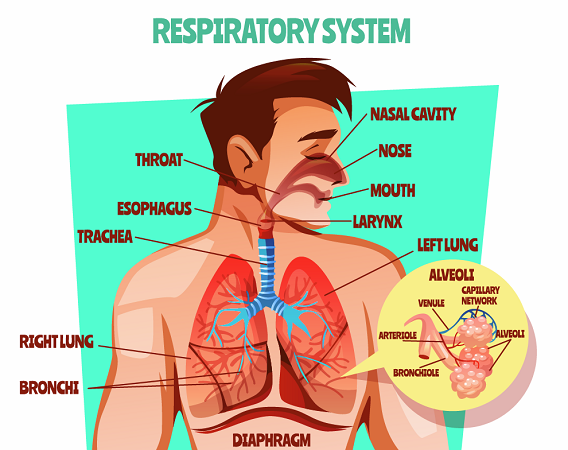Respiratory System 101
Episode #3 of the course Breathwork: Science and practice by David Urbansky
In today’s lesson, you will learn which organs and processes are involved when you take a good deep breath of fresh air. All involved organs are part of the respiratory system as shown below.
Body Parts Involved
We can classify the involved organs in the upper system, lower system, and muscles.
Upper System
• Mouth and nose: Air enters and leaves.
• Nasal cavity: Air passes from the nose into the nasal cavity and then into the lungs. When air enters your nose, small hairs in your nose immediately filter out larger particles such as dust. Air then proceeds to the nasal conchae where it is humidified and warmed and smaller particles are filtered out by the surrounding mucous membranes.
• Throat: Air from the mouth is sent to the lungs via the throat.
• Voicebox: This part of the throat helps air to pass into the lungs and keeps out food and drink preventing you from choking.
Lower System
• Lungs: Left and right lungs with a tree-like structure holding a volume of about 4-6 liters (women and men respectively), but can be up to 15 liters in trained divers [1]!
• Trachea (windpipe): A hard structure so it doesn’t collapse with pressure changes.
• Bronchi and bronchioles: These are the connecting “highways” for air to the alveoli.
• Alveoli: You have about 500 million microscopic air sacs (alveoli) in your lungs that together make up the surface area of half a tennis court!
Muscles
• Diaphragm: A dome-shaped muscle that separates the chest from the abdomen. When breathing with your diaphragm, you should see your belly move out when inhaling.
• Intercostal muscles: Muscles between the ribs that expand the rib cage and allow for breathing. When you use those, you feel your shoulders lifting and your rib cage expanding. These should only be accessory muscles; during stress, they are predominantly used and lead to shallow breathing.
Breathing Cycle
The breathing cycle that you repeat about 30,000 times daily consists of two simple parts, inhaling and exhaling. During normal breathing, inhaling requires muscular activity while exhaling is simply letting the airflow back out.
Inhale
1. During inhalation, your main breathing muscle, the diaphragm, contracts and creates room for the lungs. Lower pressure in the lungs allows air to flow in.
2. The incoming air goes through your nostrils (not mouth), into your nasal cavities, through the windpipe, and into the lungs.
3. In the lungs, the air reaches the alveoli (air sacs), where the gas exchange of O2 and CO2 takes place (which takes only three-quarters of a second).
4. From the alveoli, the oxygen diffuses into the blood, attaches to red blood cells, and moves to the heart where the O2 rich blood is then pumped into every corner of your body.
Exhale
1. Every cell in your body likes to use O2 as a source to metabolize sugars, fats, and proteins for energy. The waste product is CO2 which is released into the blood.
2. To get rid of the CO2, the blood travels through the veins and heart into the lungs where the CO2 diffuses from the blood into the lungs.
3. The exhale during relaxed breathing is usually passive, meaning your diaphragm relaxes which compresses the air in the lungs and pushes the CO2-rich air out of your body.
This whole cycle happens about 12-20 times per minute. Every time you take a breath, about 500ml (a large glass full of air) enters your lungs. That is 6-10 liters per minute. As you can see, you are constantly consuming lots of air, which directly connects to your blood, so it is important that the air is clean.
Pro Tip: Don’t slouch when sitting, bad posture hinders your diaphragm movement.
In this lesson, you have learned how breathing actually works. Now, you might be thinking—great, but I already did it right without knowing all that! You sure did, but knowledge is power and the upcoming breathing exercises are built upon this knowledge. Tomorrow we will look at what we’re actually breathing when we say “air”. Also, you will learn one extremely crucial aspect of everyday breathing which alone will improve your breathing game. See you tomorrow!
Recommended book
The Oxygen Advantage by Patrick McKeown
References
[1] Freediver Herbert Nitsch – Official Biography
Share with friends


